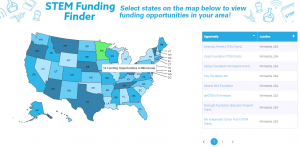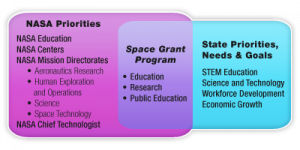Robotics, 3D printers, engineering supplies – all these items cost money. Unless your school is well-endowed, you might find yourself looking for funding opportunities elsewhere. Especially now in the wake of COVID-19, resources are being shifted to support distance learning so finding outside sources of funding can be critical.
Not sure where to look? You’re already in the right spot. We created a free funding finder tool to help you find funding opportunities within your community with nearly 800 different opportunities within the US to get you started. STEM funding is provided from a variety of different sources. Read on to learn more about the different types of funding opportunities available to STEM educators.

State Funding
Typically, your department of education has a grant resource site. States receive funding from their annual budget and some opportunities require an application. You’ll find that many states have specific grants available for funding STEM and it’s a great place to start!
Space Grant Consortiums
The Space Grant Program is a NASA initiated and funded program. There are 52 consortia including one in each of the 50 states, as well as one in Washington, D.C. and Puerto Rico. While the funding is federal, it is sent to each state’s consortia and may only be spent in those states. Typically, this funding is geared towards undergraduate and graduate students studying astronomy-related programs, but many consortia have expanded their opportunities to include K-12 students interested in topics like astronomy, physics, engineering, robotics, and more.

Parent Teacher Associations
You’re likely already familiar with your school’s PTA/PTO. The National PTA’s mission “is to make every child’s potential a reality by engaging and empowering families and communities to advocate for all children.” Under this mission falls the National PTA’s STEM + Families initiative which “increases access to STEM education and careers, especially among under-represented youth, by developing, evaluating and sharing effective ways to engage families in STEM experiences, while working with partners to improve access to STEM school and community learning environments.” Since there is national support for this initiative, you’ll likely find STEM funding opportunities within your local chapter.
Corporations
Large corporations, particularly technology and energy companies, often have community grant opportunities. These companies see K-12 STEM education as workforce development. If students are not exposed to quality STEM education as children, they won’t follow the STEM pipeline towards a STEM career leaving unfilled positions at these companies. These funding opportunities can be more competitive since they are usually open nationwide, but you may find smaller, local corporations who will have less applicants (e.g. your local electric company).
Foundations
Many philanthropic groups offer education and STEM grants. These foundations may be funded by a wealthy donor or be part of a larger organization. Likely these organizations have targeted groups in mind when they award funding. For example, the Community Foundation of South Alabama only funds within the state of Alabama and gives priority to funding serving veterans and youth. Make sure you meet all the requirements of the grant and that your goals align with the foundation’s when applying to these types of opportunities.
![]()
The next step…
…is to do your homework! Use our funding finder tool to select your region and see what types of opportunities are available to you. Find opportunities that align with your end goals, write your applications, and put your funding to good use!
Check out the rest of our FREE resources here!








Leave A Comment